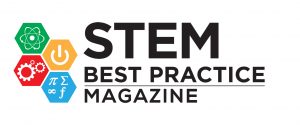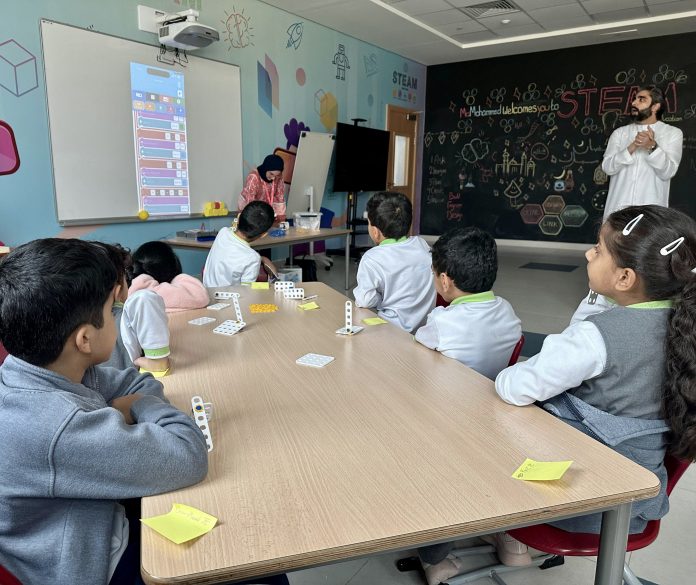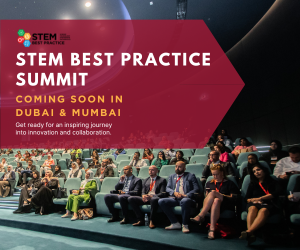Project Title: Smart Racing Car with Distance-Based LED Indicators and Action Response
Student Names: Mohammed Moosa, Latifa Mohammed, Hamad Ahmed, Eman Mohammed, Reem Suliman, Mohammed Ahmed, Hazza Ahmed, Mahra Salem, Zayed Rashed, Sultan Saeed, Ahmed Hamdan, and Shamsa Obaid
Grade Level: Grade 1, Grade 2, Grade 3
Abstract
At Al Rayaheen Charter School, we recently completed an exciting and hands-on project that introduced Grade 1, Grade 2, and Grade 3 students to the world of robotics, programming, and sensor technology. The goal was simple but impactful: we wanted our young learners to build a robotic car that could sense obstacles and respond with actions based on distance. Using an ultrasonic sensor, our students programmed their racing car to light up Red, Yellow, or Green LEDs depending on how far away an object was. This provided a visual cue that told the car whether to stop, slow down, or speed up. The project not only gave students practical experience with programming and sensor technology but also allowed them to develop critical problem-solving skills while having fun and working together.
Introduction
The Smart Racing Car project was designed to be an engaging and educational experience for our younger students. As the Digital Lead at Al Rayaheen Charter School, I wanted to introduce the students in Grades 1, 2, and 3 to basic robotics and programming in a way that was hands-on and understandable. The idea was to build a simple, autonomous racing car that could detect obstacles and react accordingly. By using an ultrasonic sensor to measure the distance to an object, the students’ car would light up an LED—Red to stop, Yellow to slow down, and Green to speed up.
What made this project so special was that it gave our students a tangible way to see how technology works. They could directly interact with the car, watch it react to their actions, and see the immediate results of their work. Through this process, they not only learned about sensors, programming, and automation but also gained valuable life skills such as teamwork, collaboration, and critical thinking.
Research & Background
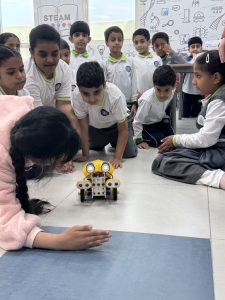 When we first began discussing autonomous vehicles, the students were fascinated by the idea that cars could “see” and respond to their environment without a driver. To make this concept more accessible, we used an ultrasonic sensor, which is simpler for younger students to understand. The sensor emits sound waves that bounce off nearby objects and return to the sensor. The time it takes for the waves to return helps the car determine how far away the obstacle is.
When we first began discussing autonomous vehicles, the students were fascinated by the idea that cars could “see” and respond to their environment without a driver. To make this concept more accessible, we used an ultrasonic sensor, which is simpler for younger students to understand. The sensor emits sound waves that bounce off nearby objects and return to the sensor. The time it takes for the waves to return helps the car determine how far away the obstacle is.
Once we had the students program the car to detect these obstacles, we introduced the concept of feedback—how the car would respond to what it “saw” through the ultrasonic sensor. The Red, Yellow, and Green LEDs were used as visual feedback, helping students understand how their programming decisions impacted the car’s actions. For many of our students, this was their first experience with such technology, and it was incredibly rewarding to see their excitement as they began to grasp the mechanics behind it.
Methodology
• Step 1: Assemble the Racing Car
The first step was to get hands-on and start assembling the Skriware robotic kit. With guidance, the students worked together to build the car, connecting the motors, wheels, ultrasonic sensor, and LEDs. What was amazing to see was the teamwork involved—our students eagerly collaborated to put together the pieces, sharing ideas and problem-solving along the way. They were excited by the challenge and took ownership of each step in the process.
• Step 2: Programming the Car Logic
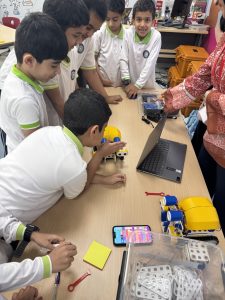 With the car assembled, we moved on to the fun part: programming! Using the Skriware Programming Software, we introduced our students to Block-based coding, a simple and intuitive platform that lets them create code by connecting visual blocks. The students learned how to program the car to detect obstacles and respond with the appropriate action.
With the car assembled, we moved on to the fun part: programming! Using the Skriware Programming Software, we introduced our students to Block-based coding, a simple and intuitive platform that lets them create code by connecting visual blocks. The students learned how to program the car to detect obstacles and respond with the appropriate action.
o If the distance was 20 cm or less, the car would stop (Red LED).
o If the distance was between 21-40 cm, the car would slow down (Yellow LED).
o If the distance was more than 40 cm, the car would go full speed (Green LED).
This step was particularly engaging because our students could instantly see the results of their coding. They tested their program, adjusting and troubleshooting as they went. This gave them a sense of ownership over the project and helped them develop resilience in the face of challenges.
• Step 3: Testing and Optimization
Once the program was in place, we began testing. Students placed objects at different distances to see if the car responded correctly. At first, some of the reactions weren’t quite as expected, which gave us an opportunity to practice debugging and problem-solving. The students worked together to adjust the code and retest the car until everything worked as planned. It was fantastic to see how engaged they were in the process, continually iterating and improving their designs.
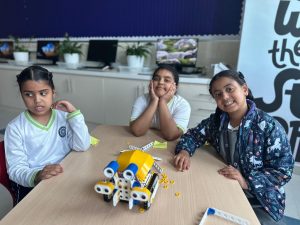
Tools & Materials
Skriware Robot Kit (including motors, chassis, and wheels)
Ultrasonic Sensor (for measuring distance)
Red, Yellow, and Green LEDs (for visual feedback)
Skriware Programming Software (for coding and controlling the car)
Project Results
• Deliverables:
The students successfully built a working prototype of an autonomous racing car that could respond to obstacles based on distance. The car was able to stop, slow down, and speed up as the distance between it and an obstacle changed. The visual feedback provided by the LEDs allowed students to see the logic behind their programming and understand how sensors could control actions.
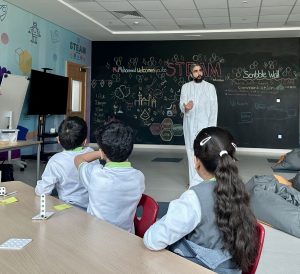 It was truly rewarding to see how proud the students were of their creations. Their sense of accomplishment grew as they tested the car and saw it respond exactly how they had programmed it. The students were thrilled to share their results with their classmates and teachers, showing off their working cars and explaining how they had programmed them to respond to different obstacles. Their excitement and pride were evident, and they were eager to take their new knowledge to the next level.
It was truly rewarding to see how proud the students were of their creations. Their sense of accomplishment grew as they tested the car and saw it respond exactly how they had programmed it. The students were thrilled to share their results with their classmates and teachers, showing off their working cars and explaining how they had programmed them to respond to different obstacles. Their excitement and pride were evident, and they were eager to take their new knowledge to the next level.
• Analysis:
Overall, the project was a huge success. Not only did our students learn the technical skills associated with programming and robotics, but they also developed important soft skills such as teamwork, communication, and problem-solving. The project provided a clear, tangible outcome that students could take pride in. It also sparked curiosity about how other technologies—such as self-driving cars—work and inspired them to think about how they can use technology to solve real-world problems.
Conclusion
 The Smart Racing Car project at Al Rayaheen Charter School has been an incredible learning experience for our Grade 1, Grade 2, and Grade 3 students. By building and programming an autonomous car, our students not only learned valuable STEM concepts but also developed critical thinking and problem-solving skills. It was amazing to watch them engage with technology in such a hands-on way, seeing the immediate impact of their work. This project has sparked a newfound interest in robotics and programming for many of our students, and we look forward to exploring even more complex systems in the future.
The Smart Racing Car project at Al Rayaheen Charter School has been an incredible learning experience for our Grade 1, Grade 2, and Grade 3 students. By building and programming an autonomous car, our students not only learned valuable STEM concepts but also developed critical thinking and problem-solving skills. It was amazing to watch them engage with technology in such a hands-on way, seeing the immediate impact of their work. This project has sparked a newfound interest in robotics and programming for many of our students, and we look forward to exploring even more complex systems in the future.
At Al Rayaheen Charter School, we believe in the power of hands-on learning, and this project is a perfect example of how young students can grasp complex STEM concepts when given the right tools and opportunities. The success of this project shows the importance of starting STEM education early, encouraging creativity, and inspiring the next generation of innovators.
About the School:
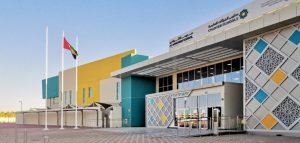 Al Rayaheen Charter School, operated by Bloom Education, is a progressive institution in Al Ain, Emirate of Abu Dhabi, serving Emirati students from KG to Grade 11. We place great emphasis on the role of technology in education and are committed to preparing students for the future from a young age. This is reflected in our dedicated STEAM programme in the elementary school, supported by a state-of-the-art STEAM Lab where students explore science, technology, engineering, arts, and mathematics in a hands-on environment.
Al Rayaheen Charter School, operated by Bloom Education, is a progressive institution in Al Ain, Emirate of Abu Dhabi, serving Emirati students from KG to Grade 11. We place great emphasis on the role of technology in education and are committed to preparing students for the future from a young age. This is reflected in our dedicated STEAM programme in the elementary school, supported by a state-of-the-art STEAM Lab where students explore science, technology, engineering, arts, and mathematics in a hands-on environment.
In addition, we incorporate cutting-edge technologies such as Virtual Reality (VR) and Augmented Reality (AR), offering immersive and interactive learning experiences that engage students in real-time problem-solving and digital exploration.
As students progress into middle and high school, our Technology programme expands to include Engineering, Robotics, Esports, and other emerging fields. This allows students to gain both theoretical knowledge and practical experience in advanced technology areas.
Al Rayaheen is also committed to ethically introducing students to Artificial Intelligence (AI) through our Technology curriculum. We aim to provide students with a solid understanding of AI technologies while ensuring they are aware of the ethical implications and real-world applications.
Through this comprehensive approach, Al Rayaheen Charter School ensures that students develop the creativity, critical thinking, and technical skills necessary to succeed in a rapidly evolving, technology-driven world.
About the Author:
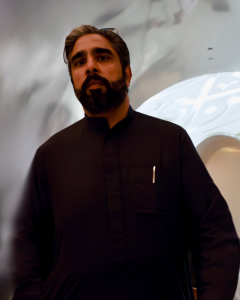 Mohammed Ahmed Bholat is the Digital Lead at Al Rayaheen Charter School, where he plays a central role in integrating technology throughout the school. His work ensures that both students and educators have access to the necessary tools and resources to thrive in today’s digital world. Mohammed’s passion for technology is complemented by the strong support of Principal Mr. Thomas Meakin, whose forward-thinking leadership helps shape the school’s digital strategy. Together, they have successfully introduced and integrated emerging technologies, including Virtual Reality (VR), Artificial Intelligence (AI), and Augmented Reality (AR), providing students with immersive learning experiences.
Mohammed Ahmed Bholat is the Digital Lead at Al Rayaheen Charter School, where he plays a central role in integrating technology throughout the school. His work ensures that both students and educators have access to the necessary tools and resources to thrive in today’s digital world. Mohammed’s passion for technology is complemented by the strong support of Principal Mr. Thomas Meakin, whose forward-thinking leadership helps shape the school’s digital strategy. Together, they have successfully introduced and integrated emerging technologies, including Virtual Reality (VR), Artificial Intelligence (AI), and Augmented Reality (AR), providing students with immersive learning experiences.
Mohammed was instrumental in launching the STEAM Lab in the elementary school, a space designed to spark curiosity and foster innovation among young learners in science, technology, engineering, arts, and mathematics. In addition, he played a key role in the creation of the Esports, Innovation, and Robotics Hubs in the middle and high school, providing students with opportunities to explore Robotics, Engineering, and Esports. These hubs encourage creativity, teamwork, and problem-solving, allowing students to engage with technology in a hands-on way. Together with Mr. Thomas Meakin, Mohammed is committed to ensuring that students not only interact with cutting-edge technologies but also understand their ethical implications, particularly in the realm of Artificial Intelligence. They work collaboratively to prepare students for the future by empowering them to engage with technology responsibly. Through their shared vision, they continue to lead Al Rayaheen Charter School’s digital transformation, enriching the educational experience and preparing students for success in a technology-driven world.

